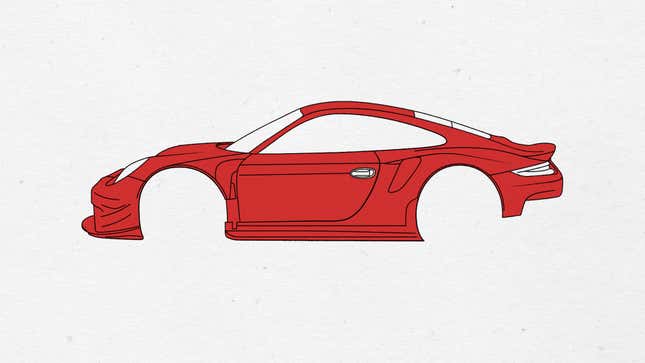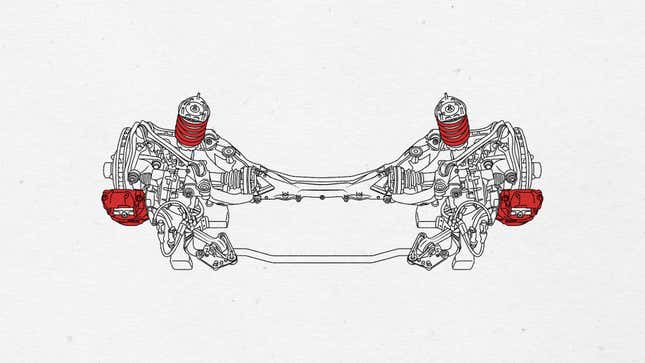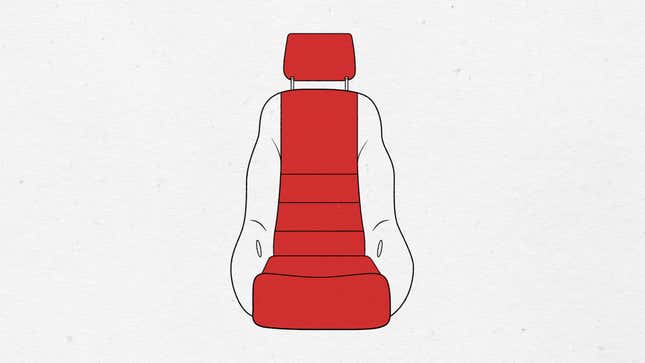Endurance races like the 24 Hours of Le Mans are often seen as the ultimate tests of man and machine. While racing drivers often get much of the credit for a good result, there’s a whole team supporting them who prepares the car to go the distance. We wanted to know how a race car gets ready for a long endurance race, so we spoke with Porsche Motorsport North America race engineer Gary Davies to find out.
Davies is responsible for race engineering the No. 911 Porsche 911 RSR in the IMSA WeatherTech SportsCar Championship as well as the No. 93 911 RSR that just raced at Le Mans. The 911 RSR is Porsche’s flagship GT racer, with a 4.0-liter flat-six engine pumping out approximately 510 horsepower.
Davies’ job entails getting as much performance out of the 911 RSR as possible as well as working with the team’s strategists on what to do during the race itself, factoring in both large-scale engineering needs and the smaller tweaks from race to race (based on things like driver preferences and the unique demands of each track).
Here are some of the key things a team must prepare for in order to keep a car racing for 24 hours.

Setting up a race car for a given track is always a matter of choosing between downforce and top speed. Downforce is the aerodynamic effect that presses the car down to the ground for more stability at speed. It’s produced when air moves over aerodynamic aids like rear wings and front splitters. Problem is, these extra aerodynamic aids also create drag that can act sort of like little air dams and ultimately thwart a car’s top speed.
Do you have long straights where spending more time at max speed is the key to the fastest lap times? Le Mans, for example, has one of the longest straights in motor racing, so being able to hit high speeds is key. You need less downforce, and thus, less drag.

Because drag is the enemy there, every panel has to fit tightly in order to get the highest possible straight-line speeds. Small gaps between body panels are minimized and the car’s ride height is lowered to make sure the car can cut through the air as efficiently as possible. “We do spend some attention to detail on the bodywork fitment, which of course, at Le Mans, because of the low downforce nature, is critical,” Davies explained.

Le Mans isn’t just grueling because it lasts for 24 hours straight. It takes place partially on public roads, and these sections can be bumpy and less forgiving than some of the better maintained purpose-built race tracks.
Drivers have been known to hop right over certain curbs as they go around the circuit, too—which are fortunately the angled track-style curbs that are meant for cars to drive over and not the taller street curbs that will bend a wheel with one wrong hit. The trick to setting up the suspension is to set it up as well as possible for most of the lap while accounting for the occasional harsh bump a driver may take.

“There are some relatively big curbs that we take at Le Mans, so the compromise is with the rest of the circuit,” Davies noted about the 911's suspension setup. “[We’re] not really concentrating on the specific ride of the curbs—it doesn’t really matter in the grand scheme of generating a lap time at Le Mans.”

Davies also works to maximize mechanical grip at the beginning of Le Mans because the racing surface itself starts out too smooth. Mechanical grip refers to the ability to maintain control of the car through its suspension and tires, as opposed to the extra grip provided by aerodynamic aids. As more race rubber rubs off onto the surface during the race, though, the surface gets much grippier, but it can be pretty slippery when all of that rubber isn’t there on the racing line, or wet conditions force them onto a different line on track.
“Everything that has the potential to fail or cause us to stop during the race is replaced when we leave,” Davies explained.
“It’s a long way [from North America to Le Mans], so everything is new,” Davies explained. “New suspension, new shock absorbers, new steering rack...new fuel pumps.”

Brakes can last for the whole length of many endurance races, but not full-24-hour ones like Le Mans. It’s a lengthy stop when the team needs to swap out its brakes, so it’s up to the drivers at Le Mans to apply less pressure when braking in order to stretch out the life of the brakes.

The brakes themselves last about 18 hours at Le Mans, so in mostly dry conditions, the team usually aims for a front brake change around sunrise on Sunday morning of the race. If they can, they’ll change the rear brakes at the same time just in case.
The team has an extra incentive to work quickly when changing the brakes, too: those brakes are hot! “The mechanics have heat-resistant gloves and need to be quick, as the gloves don’t fully protect them,” Davies said.

Because races like the 24 Hours of Le Mans bring out the best teams in sports car racing from all around the world, recent races have felt like one long sprint to the end. There’s little room for error because the cars don’t break as frequently as they did decades ago. So, everything the team plans for the race itself is meant to spend as little time in their pit stall as possible.
Teams run their full tanks to as close to empty as possible before coming in for fuel in the interest of minimizing stops. This takes about 14 laps at Le Mans for the No. 93 Porsche crew, which Davies counts as one stint. “We need to run 14 laps every stint,” Davies explained.
The team is also limited to 15 sets of tires at Le Mans, so they have to run their tires longer on some of those stints to make them last. Fortunately, this is one of the 911 RSR’s strong suits. “Generally the RSR looks after its tires better, which means that at the end of a double stint we usually have better pace than our competitors,” Davies noted.
Drivers can last multiple stints as well without needing the extra time to make a driver change. This also means that some pit stops will go even faster because the team really only needs to add fuel.
If the more complicated fuel, tire, and driver stops look a bit like a carefully choreographed and rehearsed dance on television, that’s because they are. Every day during a race event, the team spends about 15 minutes practicing driver changes. They can swap a driver in under 12 seconds, which is good, because they only have 34 seconds—the time it takes to fuel the car at Le Mans—to get the last driver out and the new one in.

“The benefit for the fast driver change is that on some occasions at the end of a race we may need to change the driver and only add a splash of fuel,” Davies said.
The team also practices how to handle failures of various major components between races so they’re ready when something goes wrong. As such, they go through the process of replacing suspension components, brakes, bumpers, splitters, and more until they’ve got it down perfect.

Keeping the driver alert and on his A-game is a team effort as well. The team ensures that the onboard drinks system is full so that the driver can stay hydrated for stints that can last for two to two and a half hours, according to Porsche driver Earl Bamber.
Each driver also gets their own molded seat insert that holds their body snugly in place, which alleviates fatigue as the driver doesn’t spend as much of his energy trying to hold himself in place in the seat as his body shifts with the movement of the car.

Le Mans cars are also required to have air conditioning systems on board to regulate cockpit temperatures. It’s still not exactly a calm, cool place to sit with the A/C going, but this was mandated for safety after drivers reported high onboard temperatures in the mid-2000s that posed real, terrifying risks to their health and safety.
Additionally, there’s a small toolkit included in the car at Le Mans. Le Mans runs on the particularly long 8.467-mile Circuit de la Sarthe, so if a driver can fix a problem he encounters further from the pits, he has some tools to do so.

A marshaling system programmed into the car for Le Mans also alerts the driver when others encounter trouble on track, for example, if the field must slow down for an incident on track, or if there’s a safety car leading cars around.

The team doesn’t get much of a break after the race, either. After any endurance race, they check all suspension and transmission components for issues. These parts may get reused in testing, but for the next race, new components including a new engine get installed on the car—just to be sure. Then the process starts all over again until the next season.
Dive deeper into the world of Porsche Motorsports to learn about all the ways these engineers achieve greatness in their race cars, and how those discoveries impact road-ready rides.

Stef Schrader is a contributor for Jalopnik. 1984 “Porschelump” 944 race car, 1971 Volkswagen 411 race car, 2010 Mitsubishi Lancer GTS.
This post is a sponsored collaboration between Porsche Motorsports and Studio@Gizmodo.

